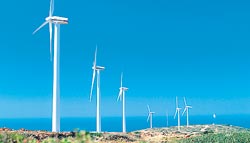
When green means moneyLONDON (AP) - Big business fears that the fight against climate change will cost billions are now giving way to a different view: green can be the colour of money. The United States, Europe and Japan are locked in a frantic race to cash in on the exploding business of saving the planet. London has become the centre for the multibillion dollar market in carbon emissions, attracting investors who trade CO2 allowances. Silicon Valley is leading the way in attracting venture capital for green technologies that shows signs of mirroring the dot-com boom -- and critics say eventual bust -- of the 1990s. And Japan's Toyota has sold more than a million Prius hybrid models, its cutting-edge eco-friendly car. Like all markets, the clean energy industry faces risks.
A sustained fall in the world's steep oil prices could make investment in alternatives to fossil fuels seem less attractive. More important, to sustain business' new attraction to clean energy, governments must maintain, or even step up, efforts to cut carbon emissions. Toward that end, a major U.N. meeting will be held in Bali, Indonesia, in December aimed at reaching a new global climate pact to succeed the Kyoto Protocol, which expires in 2012. But for now, the battle against global warming continues to offer investors an unusual chance to be idealistic and greedy at the same time."Everybody is jumping on the bandwagon," said Milo Sjardin, a senior associate at New Energy Finance, a research house in London on the world's clean energy and carbon markets. The City of London financial district has taken the lead in making billions from the management of CO2 emissions, one of the fastest-growing segments in financial services. The carbon market was created after Europe signed the 1997 Kyoto agreement on curbing green house gases. In 2005, European governments started capping the amounts of carbon dioxide that industries could emit, while letting them buy and sell CO2 emission allowances. The cap-and-trade system encourages factories and industries to cut emissions by giving them "pollution permits." If they produce less greenhouse gases than the total of their permits, they can sell the surplus certificates - also known as credits - to companies that find them cheaper than cutting their own emissions. That created the fast-growing carbon markets, where certificates are bought and sold like a commodity. It also includes investments in projects that help to generate additional credits. About US$30.4 billion (euro22.4 billion) of allowances were traded last year, representing 1.6 billion tons of CO2, double the volume of 2005, said Point Carbon, a company of market analysts based in Norway. New Energy Finance estimates that US$33.8 billion (euro25 billion) carbon credits will be needed to meet targets under the Kyoto Accord and the European Emissions-Trading Scheme by 2012. Britain has emerged as the clear leader in carbon fund management, with 72 percent of private carbon funds and 50 percent of all carbon funds being managed out of London, New Energy Finance said. The United States, which rejected the Kyoto agreement, has never adopted a federal system of controls for carbon-dioxide emissions, although California has binding targets to cut CO2 emissions and other states are expected to follow. America, however, has emerged as the world leader in developing clean energy technologies. It involves a wide range of sectors, including wind, solar, biofuels, biomass (organic material to produce power and heat), energy efficiency technology, hydrogen and fuel cells, and tidal power. "General Electric has been a leader in the campaign to develop new clean technologies that allows one to save energy and make money at the same time," said Dr. Andrew Dlugolecki, head of Andlug Consulting, a strategic consultancy on climate change and the financial sector based in Perth, Scotland. He said oil companies, carmakers and power generators are increasing their investments in renewables and biofuels. Silicon Valley venture capitalists also are rushing into the business, hoping to design revolutionary technologies, drive down prices and defeat energy business giants, said Dlugolecki. Some entrepreneurs are seeking technological and scientific innovations to produce alternatives to oil and coal, while others hope to find ways of using those fuels in cleaner and more efficient ways. Other investors are pouring money into wind, solar, geothermal and hydropower as countries such as China and more than 20 states in America require a certain portion of energy sold to come from renewable sources. A recent survey of investors found many of them are turning green. Deloitte Touche's 2006 "Global Venture Capital Survey" in the Americas, the Asia-Pacific, Europe, the Middle East and Africa found that for a second year in a row respondents selected energy/environment as the sector most likely to see the highest increase in investment focus. That also has led to a word of caution for investors. "There's a lot of money chasing not so many ideas, so the prices are going up fast, raising some concern that this activity by venture capitalists and hedge funds could produce the next dot-com bust," said Dlugolecki. |
|| Front
Page | News | Editorial | Columns | Sports | Plus | Financial
Times | International | Mirror | TV
Times | Funday
Times || |
| |
Copyright
2007 Wijeya
Newspapers Ltd.Colombo. Sri Lanka. |
